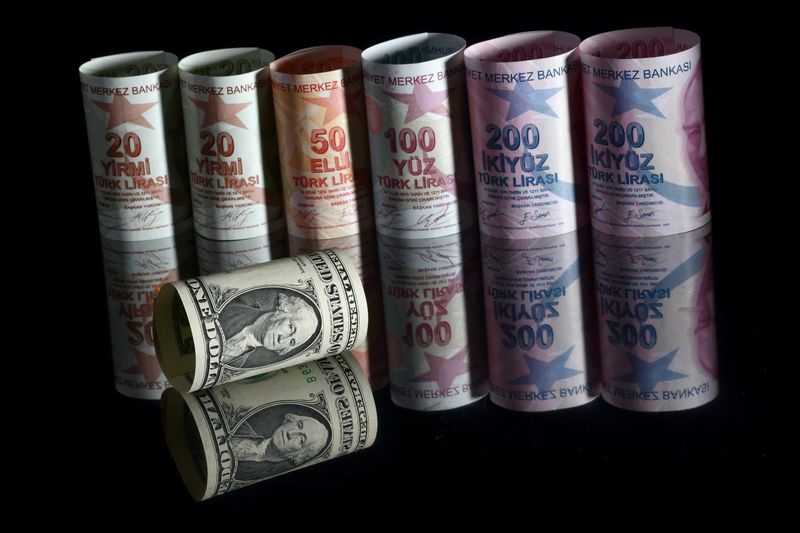
© Reuters. A U.S. one dollar banknote is seen next to Turkish lira banknotes in this illustration taken in Istanbul, Turkey November 23, 2021. REUTERS/Murad Sezer/Illustration
ISTANBUL (Reuters) – tumbled anew on Wednesday towards a record low, gripped by worries over soaring inflation and other economic fallout, after a 15% crash a day earlier that was driven by President Tayyip Erdogan’s defence of recent rate cuts.
The lira weakened as far as 13.1500 against the dollar before edging back to 13.05 by 0703 GMT. On Tuesday it touched an all-time low of 13.45.
The currency has hit record lows in 11 consecutive sessions, bringing its losses since the start of the year to 43%, with a near 24% decline since the beginning of last week.
Despite Erdogan defending the central bank’s monetary policy and vowing to win his “economic war of independence”, there is widespread criticism from those calling for action to reverse the slide in the currency, including from top economists.
There was no hint at an intervention to stem the meltdown. The central bank said on Tuesday it could only do so under certain conditions in “excessive volatility”.
“With today’s exchange rate, official inflation could exceed 30% in the coming months. With the current deposit rate this means a real interest rate of -15%,” former central chief economist Hakan Kara wrote on Twitter (NYSE:).
“If measures are not taken urgently, the financial system cannot cope with this,” he added.
Erdogan has applied pressure on the central bank to pivot to an aggressive easing cycle that aims, he says, to boost exports, investment and jobs – even as inflation soars to near 20% and the currency depreciation accelerates, eating deeply into Turks’ earnings.
Many economists called the rate cuts reckless while opposition politicians appealed for immediate elections. Turks told Reuters the dizzying currency collapse was upending their household budgets and plans for the future.
After a meeting between Erdogan and central bank Governor Sahap Kavcioglu, the bank issued a statement saying the selloff was “unrealistic and completely detached” from economic fundamentals.
Tuesday’s slide was the lira’s largest since the height of a currency crisis in 2018 that led to a sharp recession, and brought on three years of sub-par economic growth and double-digit inflation.
The central bank has slashed rates by a total of 400 points since September, leaving real yields deeply negative as virtually all other central banks have begun tightening against rising inflation, or are preparing to do so.
Fusion Media or anyone involved with Fusion Media will not accept any liability for loss or damage as a result of reliance on the information including data, quotes, charts and buy/sell signals contained within this website. Please be fully informed regarding the risks and costs associated with trading the financial markets, it is one of the riskiest investment forms possible.
Stay connected with us on social media platform for instant update click here to join our Twitter, & Facebook
We are now on Telegram. Click here to join our channel (@TechiUpdate) and stay updated with the latest Technology headlines.
For all the latest Business News Click Here
For the latest news and updates, follow us on Google News.
